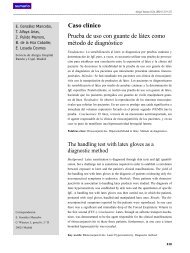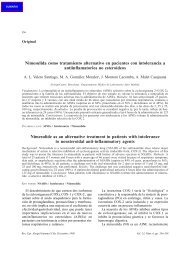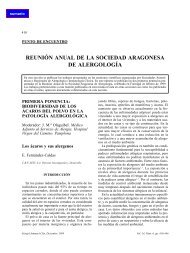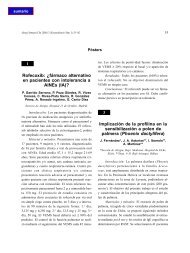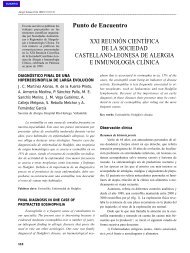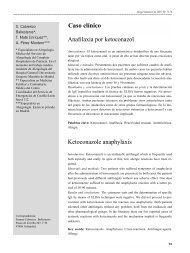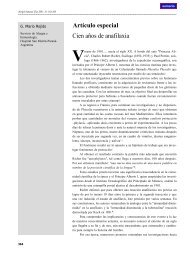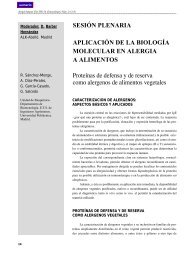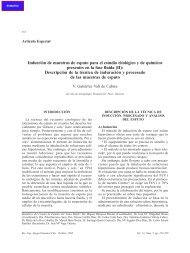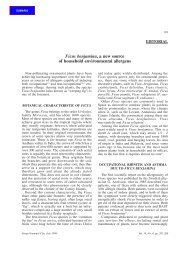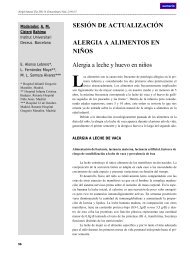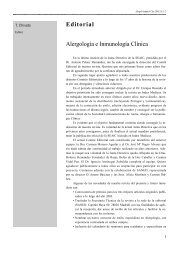Antihistamines: a review
Antihistamines: a review
Antihistamines: a review
You also want an ePaper? Increase the reach of your titles
YUMPU automatically turns print PDFs into web optimized ePapers that Google loves.
No. 5 H1 <strong>Antihistamines</strong>: a <strong>review</strong> 307<br />
tic actions 9 . During the '70s and '80s it was one of<br />
the most widely used antihistamines in our<br />
country despite its potential toxicity: it can cause<br />
blood dyscrasias, neuro- and hepatotoxicity and<br />
diverse skin reactions such as contact urticaria,<br />
systemic contact dermatitides and phototoxic and<br />
photoallergic reactions 60 .<br />
SECOND-GENERATION H 1<br />
ANTIHISTAMINES<br />
Mequitazine. A phenothiazine derivative similar<br />
to prometazine but without sedative effects at<br />
the recommended dosages; this characteristic has<br />
been attributed in principle to a greater affinity of<br />
the drug for the peripheral than for the central H1<br />
receptors 2 . Similar to other antihistamines, mequitazine<br />
has evidenced bronchodilator activity<br />
which was in this case ascribed to the calmodulininhibiting<br />
ability of phenothiazines, which would<br />
thus interfere the action of phospholipase A 2 61 .<br />
With the exception of the absence of sedation at<br />
low dosages, its adverse effects are those of phenothiazines<br />
as a group 9 .<br />
Ketotifen. A derivative of the tricyclic compound<br />
benzo-cyclo-heptathiofene, this drug has<br />
been marketed as a membrane stabiliser for the<br />
effector cells of the allergic reactions. Its pharmacologic<br />
profile is similar to that of the cromones,<br />
and it is orally active 62 . Its main action, however,<br />
is a double competitive and non-competitive inhibition<br />
of the H1 receptor 2 . It shares with other<br />
older antihistamines the sedative and antiserotoninergic<br />
effects 2,6,9 .<br />
Oxatomide. This is a piperazine and structurally<br />
and chemically very similar to the antikinetotic<br />
cinarizine. Also oxatomide was marketed as a<br />
mastocyte degranulation inhibitor 63 ; however,<br />
and similar to ketotifen, its main effects are H1<br />
antihistaminic, anticholinergic and antiserotoninergic<br />
2,64 . Recent publications from Japan stress its<br />
various antiinflammatory and antiallergic<br />
actions 65,66 .<br />
Astemizole. This molecule is metabolised by<br />
the hepatic cytochrome p-450 to demethyl-astemizole<br />
(DMA), which has significant antihistamine<br />
activity. Once oral administration is begun, stable<br />
plasma concentrations of astemizole are achieved<br />
after one week, and the plasma concentrations of<br />
astemizole plus its metabolites persist for over<br />
four weeks 31 . Astemizole has a half-life of 1.1<br />
days, and its metabolite DMA 9.5 days 4 . The suppressive<br />
effects on the skin response to histamine<br />
and the histamine-induced bronchoconstriction<br />
may persist for four to six weeks (Table II). As<br />
pointed out earlier, it is subject to the drug interactions<br />
of other antihistamines metabolised by<br />
the hepatic cytochrome p-450 and together with<br />
DMA is potentially cardiotoxic 36,46 . Astemizole<br />
has not been associated to drowsiness, but it has<br />
been associated to weight gain4.<br />
Terfenadine. This is chemically a butyrofenone<br />
derivative 29 and it is the most representative one<br />
among the non-sedative antihistamines, as it does<br />
not cross the haemato-encephalic barrier due to its<br />
phenylbutanol structure 8 . Its half-life is 16 to 24<br />
hours and, as already stated, it is a prodrug acting<br />
through its acid metabolite, terfenadine carboxylate<br />
or fexofenadine, after first-pass hepatic metabolism.<br />
Terfenadine rapidly inhibits the skin response<br />
to histamine, and this effect persists for<br />
seven days more after the withdrawal of the<br />
drug 4,29 . Its drug interactions and its cardiotoxic<br />
potential have already been discussed. In a number<br />
of studies, the side effects of terfenadine on<br />
the CNS and on the gastrointestinal tract, as well<br />
as its anticholinergic effects, have been similar to<br />
those of placebo 9 .<br />
Azelastine. This is a ftalazinone derivative and<br />
structurally unrelated to other antihistamines. It<br />
was initially investigated for oral use as an inhibitor<br />
of the mastocitary release of inflammatory<br />
mediators 67 . It is metabolised through hepatic oxidation;<br />
although it has a 22-hour half-life, its<br />
pharmacologically active major metabolite,<br />
demethyl-azelastine, has a half-life of 54 hours 68 .<br />
It is available in Spain for topical use as nasal<br />
spray and eye drops, and has demonstrated significant<br />
inhibition of the intranasal response to histamine<br />
69 and effectiveness in the control of the<br />
symptoms of rhinitis similar to that of a number<br />
of systemic antihistamines 70 . Dysgeusia, or changes<br />
in taste perception, is the most frequently<br />
reported adverse effect 4,70 .<br />
Levocabastine. This cyclohexyl-piperidine was<br />
developed for topical ocular and nasal administration.<br />
It has a 35 - 40 hour half-life and little or no<br />
systemic absorption 71 . In controlled studies it has<br />
been less effective that topical steroids 4 but at




